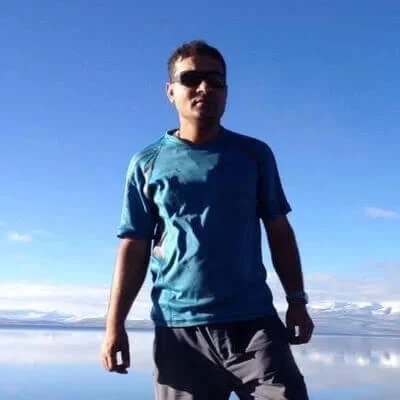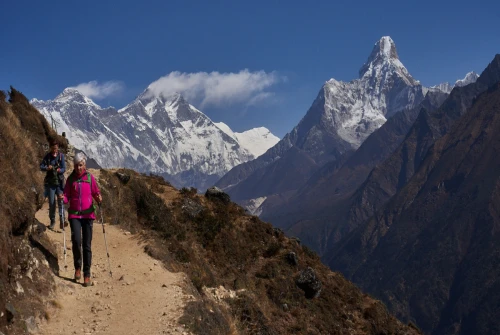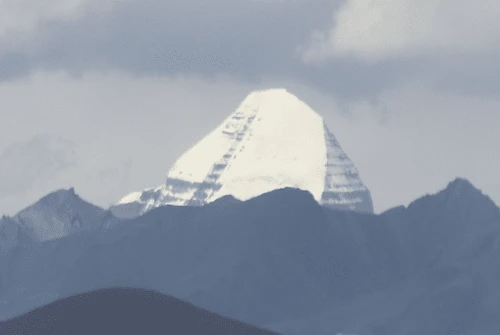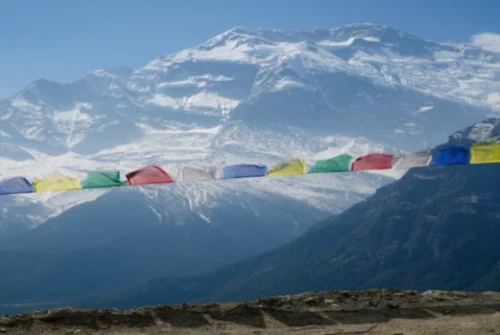Everest Base Camp Trek – The Gateway to the Roof of the World

Everest Base Camp Trek (EBC) Trek is Nepal’s most iconic and sought-after trekking journey, offering a once-in-a-lifetime opportunity to stand at the foot of the world’s highest mountain Mount Everest (8,848m). Often described as one of the most beautiful treks in Nepal and even the world, this adventure blends jaw-dropping Himalayan scenery, ancient Buddhist culture, and high-altitude challenge into a truly unforgettable experience.
This 130 km round-trip trek begins with a scenic flight from Kathmandu to Lukla, followed by a trail that winds through legendary Sherpa villages like Namche Bazaar, Tengboche, and Dingboche. Along the way, trekkers enjoy breathtaking views of Everest, Lhotse, Nuptse, and Ama Dablam, as well as panoramic vistas from Kala Patthar (5,545m) the best viewpoint of Everest without climbing it.
For those seeking a less strenuous or shorter experience, the Everest Base Camp Helicopter Tour is a spectacular alternative. And for trekkers who prefer not to fly, there’s also the EBC Trek by road via Phaplu or Jiri, ideal for scenic overland explorers.
Quick Trek Insights
Trek Name: Everest Base Camp Trek (EBC Trek)
Maximum Elevation: 5,545 meters (Kala Patthar) / 5,364 meters (Base Camp)
Trek Duration: 12–16 Days
Trek Category: Challenging
Accommodation Type: Teahouses and Local Lodges
Best Seasons: Spring (March–May) and Autumn (September–November)
Trek Restrictions: None (open to both FITs and guided groups)
Trek Permits Required: Sagarmatha National Park Entry Permit & Khumbu Pasang Lhamu Rural Municipality Permit
Major Highlights
Stand at the legendary Everest Base Camp (5,364m)
Witness awe-inspiring views from Kala Patthar (5,545m)
Scenic mountain flight to Lukla Airport
Explore the bustling Sherpa capital, Namche Bazaar
Visit the historic Tengboche Monastery
Stunning views of Mount Everest, Lhotse, Nuptse, and Ama Dablam
Immerse yourself in Sherpa culture and Buddhist traditions
Cross iconic suspension bridges over roaring glacial rivers
Important Trekking Tips
Acclimatize gradually to avoid altitude sickness—follow the rule: climb high, sleep low.
Hire a licensed guide and porter for better safety, navigation, and local insights.
Pack appropriately with layers for warmth, good hiking boots, and high-SPF sun protection.
Consider travel insurance that covers helicopter evacuation for emergencies.
Avoid trekking during the monsoon or deep winter for safety and better visibility.
Popular Side Trips Along the EBC Route
Kala Patthar Sunrise Hike:A steep morning climb for the most panoramic sunrise view of Mount Everest, plus Pumori, Nuptse, and the Khumbu Glacier.
Chhukung Valley Detour:A tranquil side trail from Dingboche leading to Island Peak Base Camp and offering dramatic vistas of Ama Dablam and the Imja Valley.
Everest View Hotel Excursion (from Namche):A short acclimatization hike with some of the best early views of Everest, perfect for rest days.
Annapurna Circuit Trek – The Journey Through Nepal’s Diverse Mountain Kingdom
 The Annapurna Circuit Trek is one of the most diverse and rewarding long-distance treks in the world. Known for its dramatic variation in landscapes, cultures, and climates, this legendary route encircles the Annapurna Massif and crosses the Thorong La Pass (5,416m) one of the world’s highest trekking passes.
The Annapurna Circuit Trek is one of the most diverse and rewarding long-distance treks in the world. Known for its dramatic variation in landscapes, cultures, and climates, this legendary route encircles the Annapurna Massif and crosses the Thorong La Pass (5,416m) one of the world’s highest trekking passes.
Starting from the lush subtropical valleys of Besisahar or Dharapani, the trail winds through Manang, crosses high Himalayan passes, and descends into the arid Tibetan-influenced landscapes of Mustang, eventually reaching Jomsom or continuing to Tatopani. From rice paddies to alpine deserts and icy peaks to sacred temples, the Annapurna Circuit offers an immersive experience of Nepal’s cultural and ecological diversity.
This trek is ideal for adventurers looking for an extended journey with constant scenery changes and rich cultural encounters.
Quick Trek Insights
Trek Name: Annapurna Circuit Trek
Maximum Elevation: 5,416 meters (Thorong La Pass)
Trek Duration: 14–21 Days
Trek Category: Moderate to Challenging
Accommodation Type: Teahouses and Lodges
Best Seasons: Spring (March–May) and Autumn (September–November)
Trek Restrictions: None
Trek Permits Required:TIMS Card & Annapurna Conservation Area Permit (ACAP)
Major Highlights
Cross the thrilling Thorong La Pass (5,416m) – a major high-altitude achievement
Explore the sacred Muktinath Temple, revered by both Hindus and Buddhists
Trek through diverse terrain – from rice fields and waterfalls to alpine deserts
Enjoy a soak in the natural hot springs at Tatopani
Experience cultural variety: Gurung, Thakali, Tibetan-influenced communities
Traverse the Kali Gandaki Gorge – the world’s deepest gorge
Breathtaking views of Annapurna I, Dhaulagiri, Manaslu, Gangapurna, and Tilicho Peak
Trekking Tips
Start slow and build up altitude gradually for proper acclimatization
Hydrate well, especially before and after Thorong La Pass
Avoid crossing Thorong La in bad weather or without proper preparation
Consider a rest day in Manang to adjust to the altitude and explore local sights
Pack for changing climates – from tropical valleys to freezing passes
Side Trips Along the Annapurna Circuit
Tilicho Lake (4,919m): A stunning, high-altitude lake nestled beneath Tilicho Peak. It's one of the highest lakes in the world and a highly recommended detour from Manang.
Poon Hill Sunrise Trek:Add a short detour from Tatopani or Ghorepani to enjoy the famous sunrise over the Annapurna and Dhaulagiri ranges ideal for trekkers with a flexible itinerary.
Ice Lake (Kicho Tal):A lesser-known but spectacular day hike from Manang offering views of Chulu East, Gangapurna, and Annapurna II.
Manaslu Circuit Trek – A Journey into Nepal’s Untouched Himalayan Wilderness
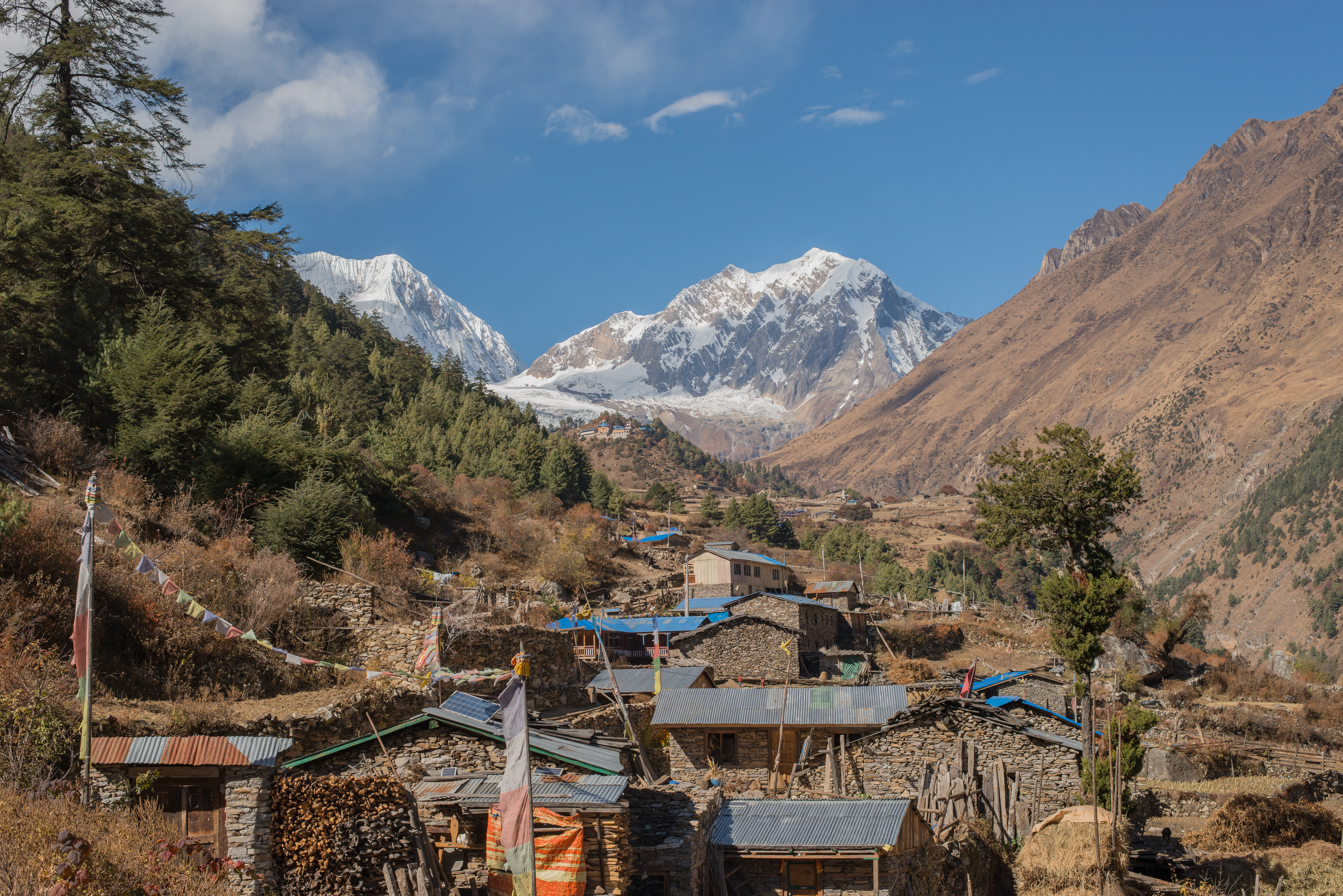 The Manaslu Circuit Trek offers a thrilling and remote trekking experience around Mount Manaslu (8,163m), the world’s eighth highest peak. This less-crowded route takes trekkers through untouched landscapes, traditional Tibetan Buddhist villages, and dramatic mountain passes, making it a perfect choice for adventurers seeking solitude and authentic cultural encounters.
The Manaslu Circuit Trek offers a thrilling and remote trekking experience around Mount Manaslu (8,163m), the world’s eighth highest peak. This less-crowded route takes trekkers through untouched landscapes, traditional Tibetan Buddhist villages, and dramatic mountain passes, making it a perfect choice for adventurers seeking solitude and authentic cultural encounters.
Crossing the challenging Larkya La Pass (5,160m), this trek showcases breathtaking views of Manaslu and the surrounding Himalayan giants, deep river gorges, and rugged trails. Due to its location in a restricted area, trekkers must obtain special permits and trek with a licensed guide, ensuring responsible tourism and protection of local cultures.
Quick Trek Insights
Trek Name: Manaslu Circuit Trek
Maximum Elevation: 5,160 meters (Larkya La Pass)
Trek Duration: 14–18 Days
Trek Category: Challenging
Accommodation Type: Teahouses
Best Seasons: Spring (March–May) and Autumn (September–November)
Trek Restrictions: Restricted Area (special permit and guide required)
Trek Permits Required:Manaslu Restricted Area Permit (RAP) ,Manaslu Conservation Area Permit (MCAP) & Annapurna Conservation Area Permit (ACAP)
Major Highlights
Cross the dramatic and challenging Larkya La Pass (5,160m)
Explore remote Tibetan Buddhist villages with rich traditions
Witness pristine alpine landscapes and deep river gorges
Enjoy spectacular panoramic views of Mount Manaslu and nearby peaks
Experience genuine local culture in villages like Samagaun and Lho
Trek through unspoiled forests and pastures in the Manaslu Conservation Area
Trekking Tips
Trekking in the Manaslu region requires a licensed guide and a group of at least two trekkers (plus guide),solo trekking is prohibited.
Carry extra cash as ATMs and banks are unavailable in remote villages.
Ensure thorough acclimatization and take rest days as needed, especially before and after Larkya La Pass.
Prepare for basic accommodation facilities in teahouses; fewer amenities than more popular routes.
Pack appropriate gear for variable weather and rugged terrain.
Side Trips in the Manaslu Region
Tsum Valley: A hidden cultural gem, this remote valley is rich in ancient monasteries, prayer flags, and yak pastures. It offers an intimate look at Tibetan Buddhist culture and stunning natural beauty.
Manaslu Base Camp:A rewarding day hike from Samagaun providing close-up views of Mount Manaslu, ideal for climbers and photographers.
Langtang Valley Trek – A Gateway to the Hidden Himalayas
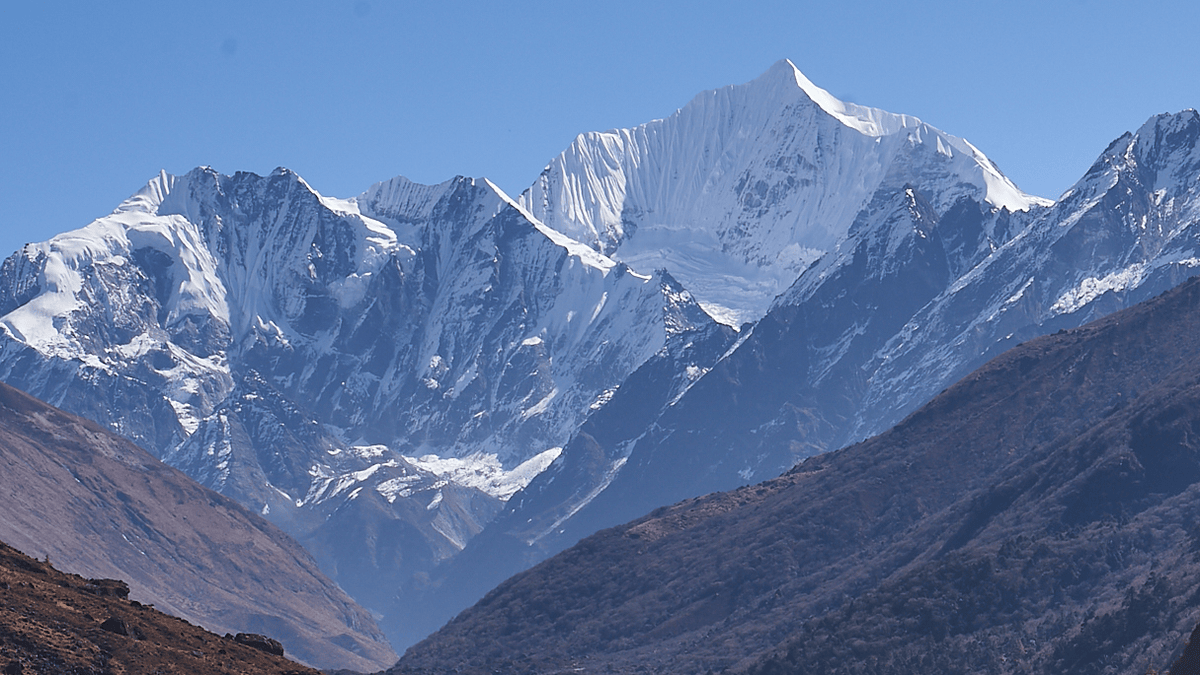
The Langtang Valley Trek offers a perfect blend of natural beauty, rich cultural experience, and moderate trekking challenge, making it ideal for those seeking a shorter yet rewarding Himalayan adventure close to Kathmandu. Trekking through the Langtang National Park, you’ll be surrounded by towering peaks, glaciers, alpine forests, and traditional Tamang villages.
The trek culminates at Kyanjin Gompa (3,870m), a historic Tibetan Buddhist monastery, offering insights into local spirituality and culture. For panoramic views, you can hike up Tserko Ri (4,984m), an excellent vantage point for catching the sunrise over the Langtang range.
Quick Trek Insights
Trek Name: Langtang Valley Trek
Maximum Elevation: 4,984 meters (Tserko Ri)
Trek Duration: 7–10 Days
Trek Category: Moderate
Accommodation Type: Teahouses
Best Seasons: Spring (March–May) and Autumn (September–November)
Trek Restrictions: None
Trek Permits Required: TIMS Card & Langtang National Park Permit
Major Highlights
Majestic views of the Langtang Himalayan Range including Langtang Lirung (7,234m)
Visit the culturally rich Kyanjin Gompa monastery and yak cheese factory
Experience the unique Tamang culture and traditional village life
Trek through dense rhododendron forests and stunning alpine landscapes
Observe beautiful glaciers and high mountain meadows
Opportunity for panoramic sunrise views from Tserko Ri
Important Trekking Tips
Plan an acclimatization day in Kyanjin Gompa to explore and avoid altitude sickness.
Start the Tserko Ri hike early in the morning to enjoy clear skies and spectacular sunrise views.
Pack warm clothing as temperatures can drop sharply at higher altitudes.
Stay hydrated and follow basic altitude sickness prevention measures.
The trail is well-established but expect some rough sections, so bring good hiking boots.
Side Trips in the Langtang Valley
Tserko Ri Summit Hike:A challenging but rewarding day hike offering some of the best panoramic views of the entire Langtang range.
Langshisa Kharka:A more remote and less frequented high pasture, perfect for trekkers seeking solitude and incredible mountain scenery.
Upper Mustang Trek – Explore the Lost Tibetan Kingdom of Nepal
The Upper Mustang Trek is a culturally immersive Himalayan journey that takes you deep into the ancient Kingdom of Lo, once a part of the Tibetan empire. This trek unveils a hidden world of desert-like landscapes, walled cities, sky caves, and ancient Buddhist monasteries that reflect centuries-old Tibetan traditions.
Located in the rain shadow of the Annapurna and Dhaulagiri ranges, Upper Mustang is one of the few treks in Nepal that’s ideal even during the monsoon. The trail leads you to the medieval walled capital, Lo Manthang (3,810m), with its royal palace, monasteries, and untouched Tibetan Buddhist culture.
Due to its status as a restricted area, this trek requires a special permit and must be done with a licensed guide, offering both exclusivity and authenticity.
Quick Trek Insights
Trek Name: Upper Mustang Trek
Maximum Elevation: 3,810 meters (Lo Manthang)
Trek Duration: 12–15 Days
Trek Category: Moderate
Accommodation Type: Teahouses and Lodges
Best Seasons: Spring (March–May), Summer/Monsoon (June–August), Autumn (September–November)
Trek Restrictions: Restricted Area – Special Permit Required
Trek Permits Required: Upper Mustang Restricted Area Permit & Annapurna Conservation Area Permit (ACAP)
Major Highlights
Explore Lo Manthang, the ancient walled capital with Tibetan Buddhist architecture and royal palaces
Visit remote monasteries such as Thubchen Gompa, Jampa Gompa, and Ghar Gompa
Witness the mystical Tiji Festival – a colorful annual celebration of Tibetan culture (May)
Trek through the trans-Himalayan desert, wind-eroded cliffs, and high-altitude canyons
Visit the Sky Caves of Chhoser, carved into vertical cliffs and filled with relics and murals
Enjoy panoramic views of Nilgiri, Dhaulagiri, and Annapurna peaks
Experience the preserved Tibetan-influenced culture of the Loba people
Walk along centuries-old salt trade routes once linking Nepal with Tibet
Important Trekking Tips
You must trek with a government-licensed guide and at least one companion due to the restricted area rule
Carry sufficient Nepali cash – no ATMs or card facilities in Upper Mustang
Weather is dry and windy, so bring appropriate windproof gear and sunglasses
Best done during summer as the region lies in a rain shadow – perfect for monsoon trekking
Include acclimatization days at higher altitudes to adjust and explore monasteries and villages
Wi-Fi and electricity are available in most villages but may be limited or require payment
Bring copies of permits for checkpoints at Kagbeni and beyond
Side Trips in Upper Mustang
Tiji Festival (May):Attend the annual three-day Tiji Festival in Lo Manthang, a traditional masked dance celebration that depicts the triumph of good over evil in Tibetan Buddhist mythology.
Chhoser Sky Caves:Visit the prehistoric caves of Chhoser, located north of Lo Manthang, believed to have been used for meditation, burial, and storage by early settlers and monks.
Ghar Gompa Detour:Make a cultural detour to Ghar Gompa, one of Mustang's oldest and most sacred monasteries, believed to fulfill wishes of devoted visitors.
Yara and Luri Gompa Exploration:Take an alternative return route via Yara and Tangge, with the option to visit Luri Gompa, a 15th-century cave monastery filled with ancient murals.
Annapurna Base Camp Trek – Into the Heart of the Annapurna Sanctuary
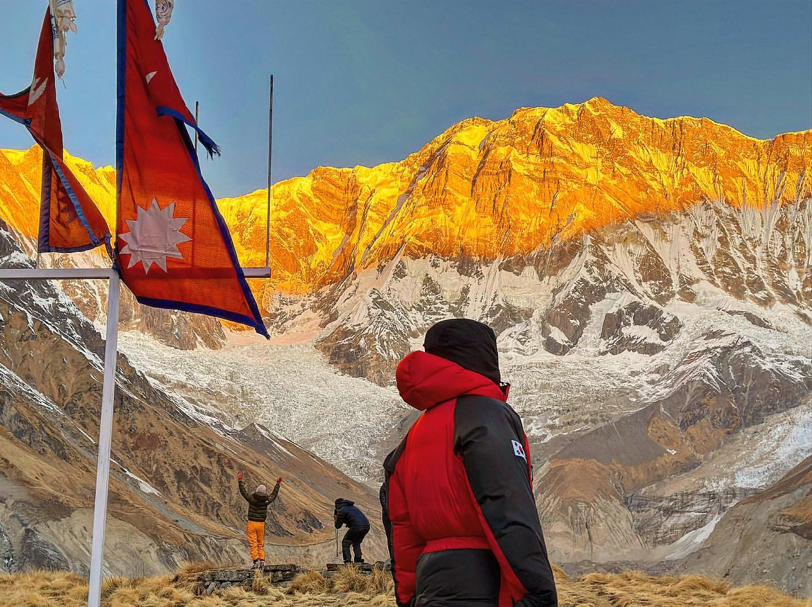
The Annapurna Base Camp (ABC) Trek is one of Nepal’s most iconic and accessible trekking adventures, leading you directly into the heart of the majestic Annapurna Sanctuary. Surrounded by towering Himalayan giants like Annapurna I (8,091m) and Machapuchare (Fishtail), this trek offers a perfect blend of alpine landscapes, lush rhododendron forests, and rich Gurung and Magar cultures.
Whether you're a first-time trekker or an experienced hiker, the moderate difficulty, well-marked trails, and comfortable teahouses make the ABC trek one of the most popular treks in Nepal.
Quick Trek Insights
Trek Name: Annapurna Base Camp (ABC) Trek
Maximum Elevation: 4,130 meters (13,550 feet)
Trek Duration: 7–11 Days
Trek Category: Moderate
Accommodation Type: Teahouses and Lodges
Best Seasons: Spring (March–May), Autumn (September–November)
Trek Restrictions: None
Trek Permits Required: TIMS Card & Annapurna Conservation Area Permit (ACAP)
Major Highlights
Reach Annapurna Base Camp (4,130m), surrounded by panoramic Himalayan views
Witness Annapurna I, Machapuchare, Hiunchuli, and Annapurna South towering above
Trek through scenic Gurung villages like Ghandruk and Chhomrong
Enjoy the vibrant forests of rhododendron, bamboo, and oak
Relax at Jhinu Danda hot springs after a long day of trekking
Stunning sunrise and sunset views from high points on the trail
Culturally enriching experience with warm hospitality from local communities
Ideal combination of mountain adventure and cultural immersion
Important Trekking Tips
Start early each day to enjoy clear skies before afternoon clouds roll in
Bring light rain gear even in peak seasons, as mountain weather can change rapidly
Respect local customs and traditions, especially in Gurung and Magar villages
Stay hydrated and well-acclimatized, particularly after 3,000 meters
Carry cash; no ATMs available along the trekking route
Prepare for basic amenities in teahouses; bring a sleeping bag for extra warmth
ABC trail is well-marked and moderately crowded during high season – consider pre-booking in October or April
Side Trips in the ABC Trek Route
Poon Hill Sunrise Hike (3,210 meters / 10,531 feet):Begin your ABC trek via Ghorepani to enjoy one of the most spectacular sunrises in the Himalayas. From Poon Hill, witness the glowing peaks of Annapurna, Dhaulagiri, Nilgiri, and Machapuchare bathed in golden morning light.
Jhinu Danda Hot Springs:After descending from base camp, make a relaxing stop at Jhinu Danda. Just a short walk downhill from the village, the natural riverside hot springs are the perfect way to soothe tired muscles and enjoy a peaceful moment in nature.
Mardi Himal Trek – A Hidden Gem in the Annapurna Region
 The Mardi Himal Trek is a short yet rewarding journey to one of the least crowded trails in the Annapurna region. Perfect for trekkers seeking a quieter path with jaw-dropping views, this trek offers an immersive Himalayan experience without the crowds of Annapurna Base Camp or Poon Hill.
The Mardi Himal Trek is a short yet rewarding journey to one of the least crowded trails in the Annapurna region. Perfect for trekkers seeking a quieter path with jaw-dropping views, this trek offers an immersive Himalayan experience without the crowds of Annapurna Base Camp or Poon Hill.
The trail winds through vibrant rhododendron forests, peaceful alpine ridgelines, and remote teahouse villages before reaching Mardi Himal Base Camp (4,500m), located directly beneath the majestic Machapuchare (Fishtail). With a perfect mix of nature, solitude, and stunning mountain panoramas, it’s an ideal choice for short treks.
Quick Trek Insights
Trek Name: Mardi Himal Trek
Maximum Elevation: 4,500 meters (14,763 feet)
Trek Duration: 4–7 Days
Trek Category: Moderate
Accommodation Type: Teahouses
Best Seasons: Spring (March–May), Autumn (September–November)
Trek Restrictions: None
Trek Permits Required: TIMS Card & Annapurna Conservation Area Permit (ACAP)
Major Highlights
Close-up and uninterrupted views of Machapuchare (Fishtail), Annapurna South, and Hiunchuli
Off-the-beaten-path trail with fewer trekkers and a serene environment
Trek along high, exposed ridgelines with dramatic drop-offs and panoramic vistas
Pass through vibrant rhododendron forests blooming in spring
Experience the tranquility of Forest Camp, Low Camp, and High Camp
Shorter trek duration makes it perfect for travelers with limited time
Authentic local hospitality and cultural immersion in hillside villages
Important Trekking Tips
Ideal for a short Himalayan adventure with grand mountain views
Nights can be chilly at higher altitudes – bring layered clothing and warm gear
The trail is less commercialized – carry snacks and essentials
Avoid monsoon season (June–August) as trail can be muddy and slippery
Begin summit hike from High Camp early in the morning for best visibility
Limited teahouses – book accommodation in advance during peak season
Drinking water is available at teahouses – bring purification tablets or bottles
Side Trips in the Mardi Himal Route
High Camp,Mardi view Point to Mardi Himal Base Camp (4,500m):The highlight of the trek – an early morning hike from High Camp to Mardi Himal Base Camp, offering sweeping sunrise views of Annapurna South, Hiunchuli, and Machapuchare. This stretch features dramatic Himalayan scenery and is the most rewarding moment of the trek.
Forest Camp Nature Walk:Spend some extra time around Forest Camp to explore the biodiversity-rich rhododendron and oak forests. It’s a peaceful area to enjoy birdwatching and photography amid lush vegetation.
Ghorepani Poon Hill Trek – The Classic Sunrise Trail of Nepal

The Ghorepani Poon Hill Trek is a popular short trek in the Annapurna region, best known for its breathtaking sunrise views over the Annapurna and Dhaulagiri ranges from Poon Hill (3,210m). Ideal for beginners, families, and trekkers with limited time, this route offers an excellent introduction to Himalayan trekking with comfortable teahouses and culturally rich villages.
Traversing through rhododendron forests, charming Magar and Gurung settlements, and scenic ridgelines, the trek provides both natural beauty and cultural insight all within a few days' walk from Pokhara.
Quick Trek Insights
Trek Name: Ghorepani Poon Hill Trek
Maximum Elevation: 3,210 meters (10,531 feet)
Trek Duration: 4–6 Days
Trek Category: Easy to Moderate
Accommodation Type: Teahouses
Best Seasons: Spring (March–May), Autumn (September–November)
Trek Restrictions: None
Trek Permits Required: TIMS Card & Annapurna Conservation Area Permit (ACAP)
Major Highlights
Experience sunrise from Poon Hill, with panoramic views of Annapurna, Dhaulagiri, Machapuchare, and Nilgiri
Hike through lush rhododendron forests, especially beautiful in spring
Visit traditional Gurung and Magar villages, known for their hospitality and culture
Enjoy short yet rewarding ascents through stone steps and scenic forest trails
Perfect for first-time trekkers, families with kids, and those short on time
Explore colorful teahouses, prayer flags, and terraced hill landscapes
No high-altitude risk, making it accessible and safe year-round (except monsoon)
Important Trekking Tips
Stay well-hydrated during long stone stair climbs, especially between Tikhedhunga and Ghorepani
Bring a light daypack and layered clothing—mornings and evenings can be chilly
Ideal for those looking for a scenic trek without high altitude challenges
Don’t miss the traditional dal bhat meals served in teahouses—it fuels you well for the hikes
Leave early for the Poon Hill sunrise hike to secure a good viewpoint spot
Carry cash – ATMs are not available along the trail
Combine with other short treks like Ghandruk or Landruk for an extended route
Side Trips in the Poon Hill Route
Tadapani Extension:Add a night in Tadapani for a more peaceful experience away from the busier Ghorepani trail. The trail from Ghorepani to Tadapani passes through deep rhododendron and oak forests, offering excellent photography and birdwatching opportunities.
Ghandruk Village Stay:Continue to Ghandruk, a beautiful Gurung village known for its cultural museum, traditional stone houses, and close-up views of Machapuchare and Annapurna South. A stay here is a great way to experience authentic mountain life before returning to Pokhara.
Gokyo Lakes Trek – A Pristine Himalayan Trek to Turquoise Glacial Lakes
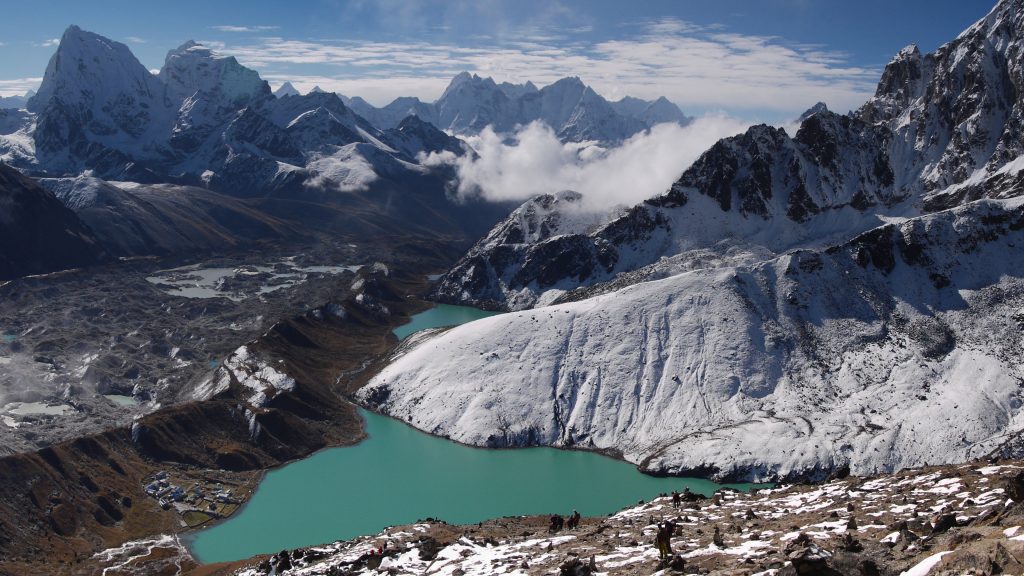
The Gokyo Lakes Trek offers a breathtaking alternative to the classic Everest Base Camp route, taking trekkers into the heart of the Gokyo Valley, home to six sacred turquoise glacial lakes, the massive Ngozumpa Glacier, and the stunning Gokyo Ri viewpoint (5,357m).
This trek rewards you with panoramic views of four of the world’s tallest peaks Everest (8,848m), Lhotse (8,516m), Makalu (8,481m), and Cho Oyu (8,188m) from a quieter and less-traveled trail. With challenging elevations, surreal high-altitude scenery, and peaceful mountain villages, the Gokyo Lakes Trek is perfect for those looking for adventure with serenity.
Quick Trek Insights
Trek Name: Gokyo Lakes Trek
Maximum Elevation: 5,357 meters (17,575 feet) at Gokyo Ri
Trek Duration: 12–15 Days
Trek Category: Challenging
Accommodation Type: Teahouses
Best Seasons: Spring (March–May), Autumn (September–November)
Trek Restrictions: None
Trek Permits Required: TIMS Card, Sagarmatha National Park Entry Permit, Khumbu Pasang Lhamu Rural Municipality (Local Permit)
Major Highlights
Summit Gokyo Ri (5,357m) for jaw-dropping sunrise views of Everest, Lhotse, Makalu & Cho Oyu
Explore six sacred glacial lakes, including the photogenic Third Lake (Dudh Pokhari)
Trek alongside the Ngozumpa Glacier, the largest glacier in the Himalayas
Enjoy fewer crowds than the traditional EBC trail, offering a peaceful experience
Visit highland Sherpa villages like Dole, Machhermo, and Gokyo
Rich biodiversity, from Himalayan thars and musk deer to high-altitude birds
Cultural encounters in Namche Bazaar and traditional teahouses along the trail
Important Trekking Tips
Take at least two acclimatization days (e.g., Namche and Machhermo) to prevent altitude sickness
Avoid alcohol and caffeine at high altitudes to stay well-hydrated
Bring backup batteries or solar chargers, as cold temperatures drain power quickly
Dress in layered clothing for rapidly changing weather conditions
Wi-Fi and charging may cost extra – plan your communication needs accordingly
Start early for the Gokyo Ri summit hike to catch clear morning skies
Carry essential snacks, as supplies become limited above Dole
Side Trips in the Gokyo Lakes Trek
Fifth Lake Exploration (Ngozumpa Tsho):Hike past the main Gokyo village to the Fifth Lake, a secluded and scenic spot offering unobstructed views of Everest and the Ngozumpa Glacier. Ideal for photographers and adventurers looking to go off the main path.
Renjo La Pass (5,360 meters / 17,585 feet):For a more adventurous loop, cross the Renjo La Pass to connect with the Thame Valley, rejoining the main trail near Namche. This is one of the Three Passes of the Everest region and offers dramatic mountain vistas and glacier landscapes.
Khopra Danda Trek – Hidden Ridge Trail with Epic Annapurna Views & Local Hospitality
The Khopra Danda Trek, also known as the Khopra Ridge Trek, is one of Nepal’s best off-the-beaten-path short treks, offering jaw-dropping views of Annapurna South (7,219m), Dhaulagiri (8,167m), and Nilgiri without the heavy crowds of more popular trails like Ghorepani or Annapurna Base Camp. This lesser-known gem takes you through peaceful rhododendron forests, high alpine pastures, and friendly Gurung and Magar villages, all while promoting sustainable community-based tourism.
At the heart of this trek is Khopra Ridge (3,660m) , a stunning balcony viewpoint perched above the clouds. You’ll also have the chance to explore the sacred Khayer Lake (4,660m) and visit Muldai Viewpoint for sunrise over 25+ Himalayan peaks. With community lodges run by locals and relatively moderate difficulty, this trek is ideal for travelers seeking natural beauty, cultural immersion, and meaningful impact.
Quick Trek Insights
Trek Name: Khopra Danda Trek (aka Khopra Ridge Trek)
Maximum Elevation: 3,660 meters (12,007 feet) at Khopra Ridge
Trek Duration: 6–9 Days
Trek Category: Moderate
Accommodation Type: Community Lodges & Teahouses
Best Seasons: Spring (March–May), Autumn (September–November)
Trek Restrictions: None
Trek Permits Required: TIMS Card, Annapurna Conservation Area Permit (ACAP)
Major Highlights
Hike to Khopra Ridge for jaw-dropping close-up views of Annapurna South, Dhaulagiri, and Nilgiri
Explore the sacred alpine Khayer Lake (4,660m) on a challenging but rewarding side trip
Support community-based tourism by staying in lodges run by local villagers
Experience diverse landscapes—from lush forests and terraced fields to alpine meadows
Enjoy a quieter and less commercialized trek than ABC or Ghorepani
Sunrise from Muldai Viewpoint, with panoramic views of over 25 Himalayan peaks
Cultural encounters with Gurung and Magar communities, known for their warmth and traditions
Important Trekking Tips
Carry sufficient Nepali cash—ATMs are not available along the trail
Acclimatize properly—even moderate-altitude treks can cause discomfort
Pack layered clothing for rapidly changing temperatures
Support locally-run community lodges to help preserve sustainable trekking routes
Add an extra night at Khopra Ridge to catch magical sunrise and sunset moments
Bring water purification tablets and light snacks for remote sections
Network is limited—expect minimal mobile and internet connectivity
Side Trips in the Khopra Danda Trek
1. Khayer Lake Hike (4,660 meters / 15,288 feet):A long and strenuous day hike from Khopra Danda, the journey to the sacred Khayer Barahi Lake rewards you with solitude, spiritual ambiance, and fantastic views of Annapurna Fang and Nilgiri. It’s considered a pilgrimage by locals.
2. Dobato to Muldai Viewpoint (3,637 meters / 11,932 feet): Add a side route via Dobato to hike up to Muldai Viewpoint, a lesser-known sunrise spot that rivals Poon Hill. You’ll be rewarded with unobstructed views of 25+ Himalayan peaks, including Machapuchare, Dhaulagiri, and Annapurna range.
FAQs
1. What are the best treks in Nepal for beginners?
The best beginner-friendly treks include Ghorepani Poon Hill, Mardi Himal, and Langtang Valley.
2. Which trek in Nepal offers the best views of Mount Everest?
The Everest Base Camp Trek and Gokyo Lakes Trek both offer spectacular views of Mount Everest.
3. When is the best time to go trekking in Nepal?
Spring (March–May) and Autumn (September–November) offer the best weather and clear mountain views.
4. What permits are needed for trekking in Nepal?
Most treks require a TIMS card and national park or conservation area permits. Restricted treks like Upper Mustang and Manaslu require special permits.
5. How difficult is the Annapurna Circuit Trek?
It’s moderately challenging due to altitude and duration, especially when crossing Thorong La Pass (5,416m).
6. Is the Everest Base Camp Trek suitable for solo trekkers?
Yes, but hiring a guide or porter is highly recommended for safety and navigation.
7. What is the most scenic short trek in Nepal?
The Mardi Himal Trek is one of the most scenic short treks, offering close-up views of Machapuchare and Annapurna South.
8. Which trek is best for avoiding crowds?
The Manaslu Circuit Trek and Khopra Danda Trek offer remote experiences with fewer trekkers.
9. Can I trek during the monsoon season in Nepal?
Most treks are not ideal during monsoon, but Upper Mustang is great due to its rain-shadow location.
10. How many days do I need for a Nepal trekking trip?
Trek durations vary from 4 to 21+ days depending on the route. You can choose based on time, fitness, and altitude comfort.
Final Thoughts on the Top 10 Treks in Nepal
Nepal’s trekking routes offer an unparalleled journey through some of the world’s most breathtaking mountain landscapes and vibrant cultures. Whether you’re drawn to the legendary Everest Base Camp, the mystical valleys of Upper Mustang, or the tranquil trails of Mardi Himal, each trek promises not just stunning views but a profound connection with the Himalayas and its people. Successful trekking in Nepal requires careful planning, proper acclimatization, and a deep respect for the local traditions that enrich every step of your adventure.
Are you ready to embark on this extraordinary journey? Let us guide you in crafting the perfect trekking experience tailored to your aspirations and abilities.For personalized trekking packages, detailed itineraries, or any questions about trekking in Nepal, please don’t hesitate to contact us.
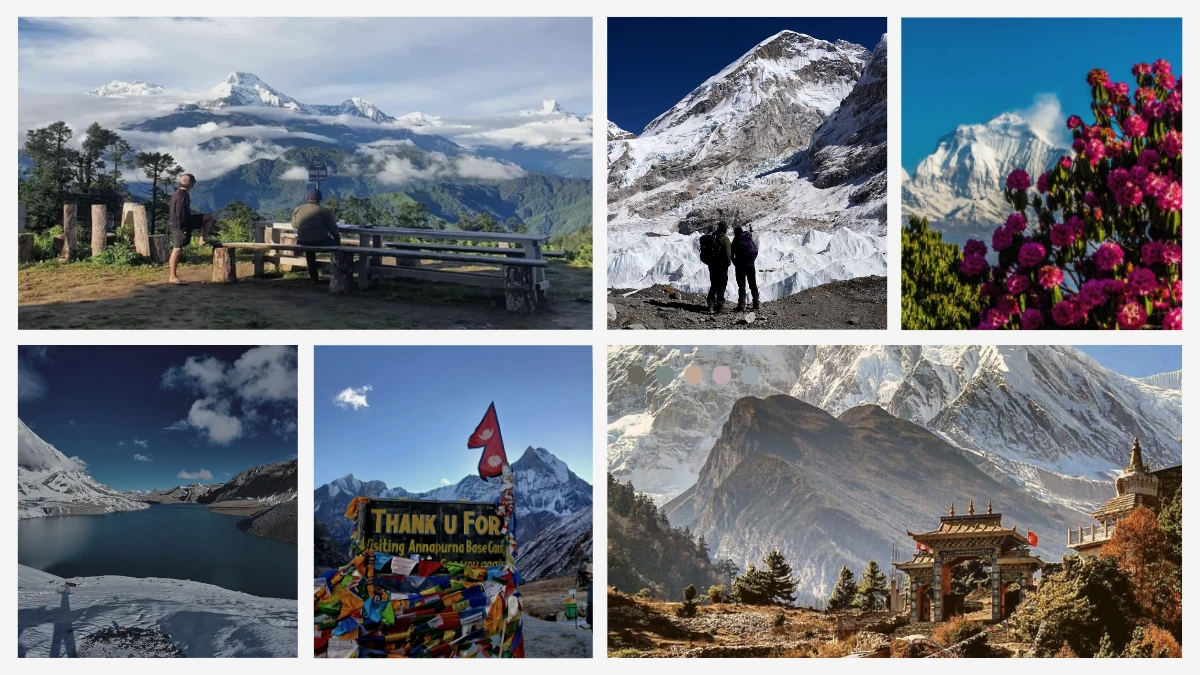

 The
The  The
The 

 The
The

